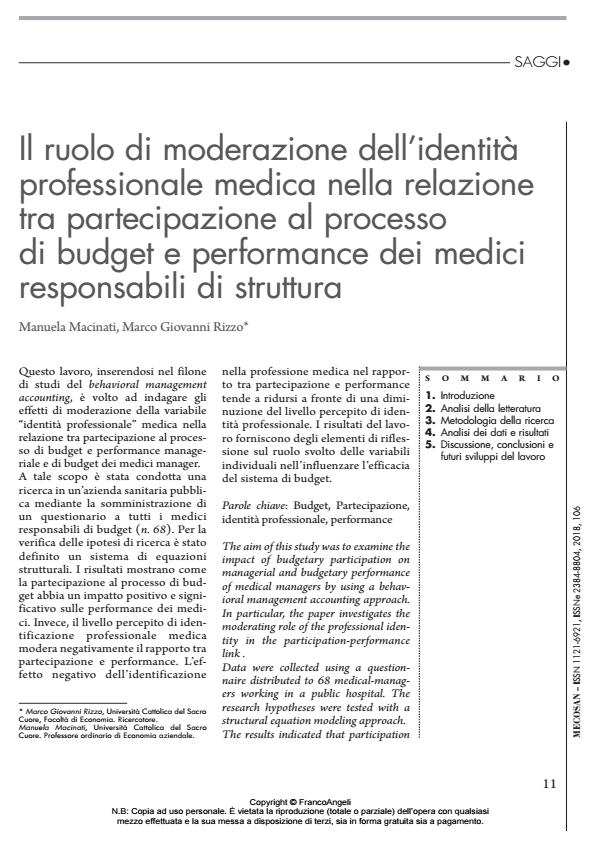Il ruolo di moderazione dell’identità professionale medica nella relazione tra partecipazione al processo di budget e performance dei medici responsabili di struttura
Journal title MECOSAN
Author/s Manuela Macinati, Marco Giovanni Rizzo
Publishing Year 2019 Issue 2018/106
Language Italian Pages 26 P. 11-36 File size 662 KB
DOI 10.3280/MESA2018-106002
DOI is like a bar code for intellectual property: to have more infomation
click here
Below, you can see the article first page
If you want to buy this article in PDF format, you can do it, following the instructions to buy download credits

FrancoAngeli is member of Publishers International Linking Association, Inc (PILA), a not-for-profit association which run the CrossRef service enabling links to and from online scholarly content.
The aim of this study was to examine the impact of budgetary participation on managerial and budgetary performance of medical managers by using a behavioral management accounting approach. In particular, the paper investigates the moderating role of the professional identity in the participation-performance link . Data were collected using a questionnaire distributed to 68 medical-managers working in a public hospital. The research hypotheses were tested with a structural equation modeling approach. The results indicated that participation had a positive effect on performance and the identification with the medical profession negatively moderates the participation- performance link. The findings of this study have managerial, policy and research implications.
Keywords: Internal budget, Budget participation, professional identity, performance
- Orientamento al feedback, soddisfazione rispetto al feedback del sistema reporting e performance di budget Manuela S. Macinati, Marco Giovanni Rizzo, in MANAGEMENT CONTROL 3/2024 pp.179
DOI: 10.3280/MACO2024-003009 - Importanza della conoscenza dell’anatomia umana di educazione fisica Robson Felipe dos Santos Leles, Polyanne Junqueira Silva Andresen Strini, Paulinne Junqueira Silva Andresen Strini, Simone Cristina Putrick, Euzebio Oliveira, Carla Viana Dendasck, in Revista Científica Multidisciplinar Núcleo do Conhecimento 65532/2017 pp.21
DOI: 10.32749/nucleodoconhecimento.com.br/salute/anatomia-umana - Soddisfazione lavorativa e work engagement nelle budgeting practices delle aziende sanitarie pubbliche. Una verifica empirica Domenico Raucci, Manuela Paolini, in MANAGEMENT CONTROL 1/2021 pp.13
DOI: 10.3280/MACO2021-001002
Manuela Macinati, Marco Giovanni Rizzo, Il ruolo di moderazione dell’identità professionale medica nella relazione tra partecipazione al processo di budget e performance dei medici responsabili di struttura in "MECOSAN" 106/2018, pp 11-36, DOI: 10.3280/MESA2018-106002